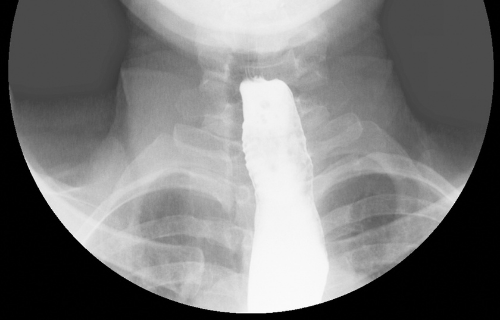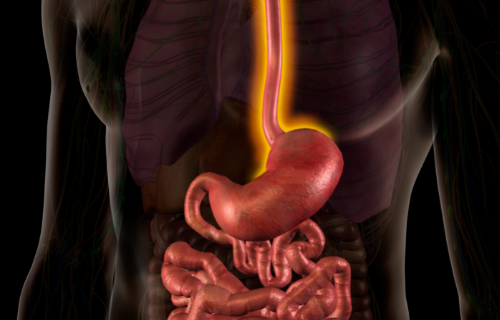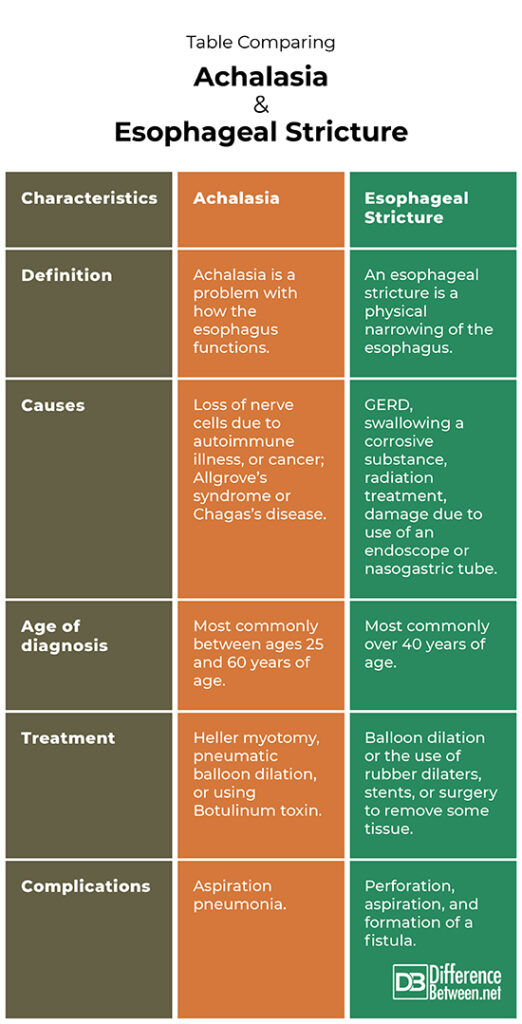Difference Between Achalasia and Esophageal stricture
Achalasia is a condition in which the esophagus does not work properly so the person struggles to swallow. Esophageal stricture is a narrowing of the esophagus making swallowing difficult.

What is Achalasia?
Definition:
Achalasia is a problem with the functioning of the esophagus that makes swallowing difficult.
Causes and risk factors:
A loss of nerve cells in the muscles of the esophagus has an adverse impact on peristalsis, which is needed for swallowing. The cause of this could be Chaga’s disease or autoimmune problems. A cancerous tumor and the genetic problem Allgrove’s syndrome also causes achalasia. These conditions are risk factors for achalasia.
Diagnosis:
An endoscopy of the esophagus (esophagoscopy) or esophageal manometry may be used for diagnosis. In the latter case, a catheter is used to measure how the esophagus contracts during swallowing. Sometimes the patient also swallows barium and an X-ray can show if the problem is achalasia or if these is a stricture in the esophagus.
Symptoms and complications:
The symptoms often start slowly and progress to difficulty in swallowing not only solid food but also liquids. Additional signs of achalasia include saliva and food being regurgitated, chest pain, night-time coughing, belching, and pain in the chest. A complication of achalasia is aspiration pneumonia in which infection develops in the lungs because food and liquid gets into the lungs.
Treatment:
Treatment options include Heller myotomy in which part of the muscle of the esophageal sphincter is excised. Another option is pneumatic balloon dilation in which widening of the sphincter is done. Botulinum toxin is sometimes injected into parts of the esophagus where muscle function is a problem. Treatment choice is likely to depend on the type of achalasia the person has.

What is Esophageal stricture?
Definition:
An esophageal stricture is an unusual and abnormal narrowing of the esophagus.
Causes and risk factors:
The most common cause of a stricture in the esophagus is uncontrolled gastroesophageal reflux disease (GERD) which damages the esophagus. Anti-inflammatories and exposure to radiation or chemotherapy may cause a stricture to form as the esophagus becomes irritated and inflamed. Cancer of the esophagus can also result in a narrowing of the organ. Having GERD or cancer are risk factors for the condition.
Diagnosis:
An esophageal stricture is diagnosed after taking an X-ray of the esophagus after a person has swallowed barium. An endoscopy, esophageal manometry, and an ultrasound may also help in diagnosis of the condition.
Symptoms and complications:
Symptoms include finding it hard to swallow, regurgitating food, feeling like the food is stuck in your chest area, heartburn, and belching. Complications of stricture include aspiration of food into the lungs, formation of a fistula, and perforation of the esophagus.
Treatment:
Treatment often aims to first open the esophagus up using a balloon dilation technique via endoscopy. Doctors may instead of a balloon, use a dilator, which is a tube made of rubber. In some cases, a stent may be used or the tissue that is obstructing the esophagus is cut away. The exact treatment depends on the type of stricture and how complex it is.
Difference between Achalasia and Esophageal stricture
Definition
Achalasia is a problem with how the esophagus functions. An esophageal stricture is a physical narrowing of the esophagus.
Causes
Causes of achalasia include loss of nerve cells in the esophagus, which may be due to autoimmune illness, or cancer, achalasia can also be caused by Allgrove’s syndrome or Chagas’s disease. Causes of esophageal stricture include having GERD, swallowing a corrosive substance, radiation treatment, or damage due to use of an endoscope or nasogastric tube.
Age of diagnosis
Achalasia is most often diagnosed in people who are between 25 and 60 years old. Esophageal stricture is most frequently diagnosed in people older than 40 years of age.
Treatment
Treatment of achalasia includes Heller myotomy, pneumatic balloon dilation, or using Botulinum toxin. Treatment of esophageal stricture includes balloon dilation or the use of rubber dilaters, stents, or surgery to remove some tissue.
Complications
A complication of achalasia is aspiration pneumonia. Complications of esophageal structure include aspiration, perforation, and formation of a fistula.
Table comparing Achalasia and Esophageal stricture

Summary of Achalasia and Esophageal stricture
- Both achalasia and esophageal stricture make it difficult to swallow.
- Achalasia is similar to an esophageal stricture but does not involve narrowing of the esophagus.
- Esophageal stricture can be treated at first by widening of the esophagus.
FAQ
Is achalasia a stricture?
Achalasia is not a stricture but is related to how the muscles and sphincter of the esophagus work.
What is an esophageal stricture?
A stricture is when a part of the esophagus that becomes too narrow causing problems when a person tries to swallow.
What are the 3 types of achalasia?
Type I achalasia is when the lower esophageal sphincter is not relaxing properly and there are some issues with muscular action in the esophagus. Type II is more serious and is when the esophageal function is worse and muscles are tighter than in type I. Type III is noted as having a lot of unpredictable spasms in the muscles of the esophagus.
Is esophageal stricture the same as esophagitis?
While there may be some link between a stricture and esophagitis, they are not the same thing. A stricture is literally a narrowing of the esophagus while esophagitis is inflammation of the organ
- Difference Between Rumination and Regurgitation - June 13, 2024
- Difference Between Pyelectasis and Hydronephrosis - June 4, 2024
- Difference Between Cellulitis and Erysipelas - June 1, 2024
Search DifferenceBetween.net :
Leave a Response
References :
[0]Desai, Jay P., and Fady Moustarah. "Esophageal stricture." StatPearls [Internet] (2021). https://www.ncbi.nlm.nih.gov/books/NBK542209/
[1]Lynch, Kristie Lee. “Achalasia (Cardiospasm; Esophageal Aperistalsis; Megaesophagus)”. Merck Manual, 2021, https://www.msdmanuals.com/professional/gastrointestinal-disorders/esophageal-and-swallowing-disorders/achalasia
[2]Patel, Dhyanesh A., Brian M. Lappas, and Michael F. Vaezi. "An overview of achalasia and its subtypes." Gastroenterology & hepatology 13.7 (2017): 411.
